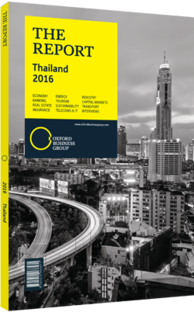Thailand seeks to expand renewables segment of energy sector
When spiking oil prices and global pressure to address climate change led to a widespread shift in the energy industry towards a greater contribution from renewable energy (RE) in the early 2000s, Thailand largely bucked this trend, preferring instead to double down on traditional fuel sources.
Alternative energy sources contribute only a very small fraction of the country’s electricity needs; at just 2.5% of the total primary energy requirements for the country in the first half of 2015, even though financial incentives for RE have been in place since 2006. The overall contribution is only slightly larger when looking solely at the electricity segment, where RE and large hydropower supplied 2.24% and 2.91%, respectively, of the total amount of electricity consumed in 2014. However, much of the country’s imported power, which accounted for 7% of overall electricity consumed in 2014, was sourced from large hydropower plants.
Future Strategy
Yet with the government becoming increasingly wary of this fossil fuel-heavy balance, a new emphasis is being placed on the nascent RE segment. After the Strategic Plan for Renewable Energy Development set a modest 8% RE target in 2004, the Renewable Energy Development Plan (2008-22) upped the target to 20% of total electricity generation from renewables by 2022. These efforts were subsequently surpassed yet again with the Alternative Energy Development Plan (AEDP) 2021 launched in 2012, which established an RE target of 25% of total energy consumption by 2021 through a varied mix of renewable technologies.
This policy was further updated in 2015 with the AEDP 2036, with these targets also reflected in the most recent Power Development Plan (PDP 2015) approved in May 2015. These include the most ambitious green energy goals yet, which call for more than doubling installed capacity of alternative energy to 19,635 MW in 2036, up from 7390 MW in use as of September 2014.
Solar energy holds by far the greatest potential energy in Thailand, with a total estimated potential exceeding 42 GW, a fact reflected in the planned 6000-MW installation target by 2036. Bioenergy is also a key focus point of the 2015 plan, with biomass power generation targets set at 5570 MW over the life of the plan and another 600 MW of biogas. Wind power is expected to provide another 3002 MW, while large and small hydropower plants are to contribute 2906 MW and 376 MW, respectively. The conversion of methane derived from municipal solid waste into gas was also set to become a significant renewable power source, with an initial target of 501 MW, which has since been revised downwards to only 400 MW, due to difficulties in negotiating with waste collection entities restricting access to these sites.
Sweetening The Pot
Renewable energy incentive programmes remain in a state of flux after initially operating on an “adder” tariff rolled out in 2006, in which an additional payment was added on top of the set power rate paid by the Electricity Generating Authority of Thailand, and later transitioning to a feed-in tariff (FiT) scheme in 2014. Under the current FiT, renewable power producers are guaranteed premium rates for power produced depending upon the technology used, thereby ensuring that these technologies are cost competitive with more conventional power plants.
New FiT contracts are granted for 20 years, an exception being power systems fuelled by landfill gas, which will receive support for 10 years only. The FiT rates vary widely depending upon power plant size and fuel types, and is slightly more complicated than similar systems employed in other countries as a result of separate categories that vary the remuneration granted and premiums paid.
You have reached the limit of premium articles you can view for free.
Choose from the options below to purchase print or digital editions of our Reports. You can also purchase a website subscription giving you unlimited access to all of our Reports online for 12 months.
If you have already purchased this Report or have a website subscription, please login to continue.

